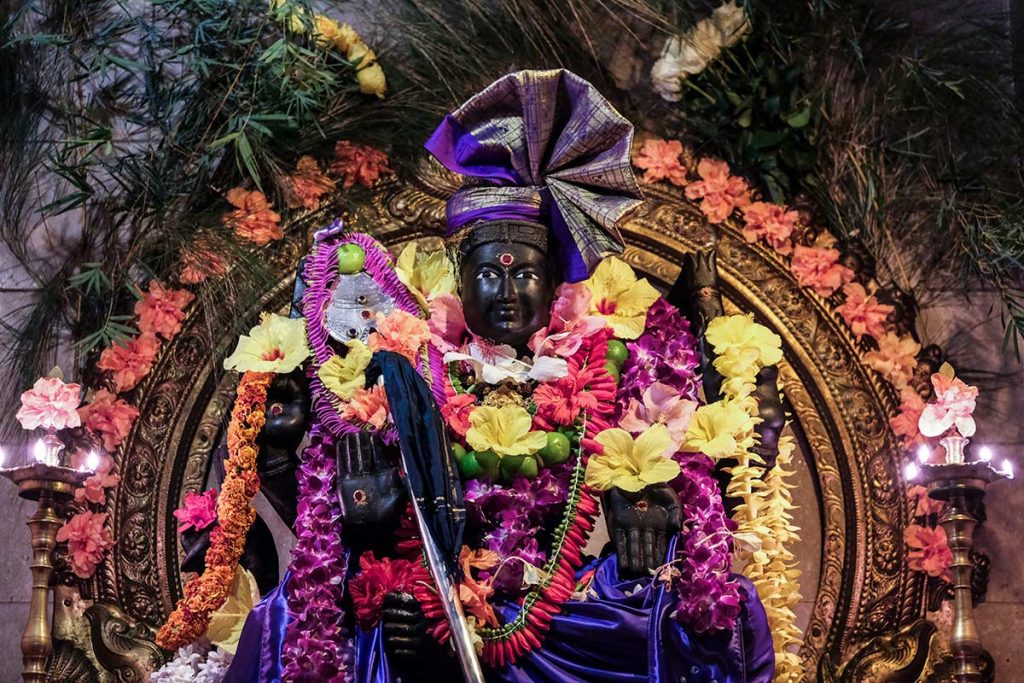Download the full-color, newspaper-page-size PDF of this special festival feature from our Festival Pager Downloads
Skanda Sashti is a six-day South Indian festival to Skanda, the Lord of Religious Striving, also known as Murugan or Karttikeya. It begins on the day after the new moon in the month of Karttika (October/November) with chariot processions and pujas invoking His protection and grace. The festival honors Skanda’s receiving His lance, or vel, of spiritual illumination, and culminates in a victory celebration of spiritual light over darkness on the final day. Penance, austerity, fasting and devout worship are especially fruitful during this sacred time.
WHO IS SKANDA?
Skanda is a God of many attributes, often depicted as six-faced and twelve-armed. Saivite Hindus hail this supreme warrior, the commander-in-chief of the great army of devas, or beings of light, a fearless defender of righteousness. They honor Him as the mystic healer of ailments and master of yoga, guiding those who persevere on enlightenment’s path. Legends say He was the first to renounce the world and step onto the path of kundalini yoga. God Siva bestowed upon His son Skanda dominion over the chakras of willpower, direct cognition, and the purest, child-like divine love. Murugan is the tutelary Deity of the Tamil community.
HOW IS SKANDA SASHTI CELEBRATED?
It is considered meritorious to undertake a six-day fast, known as the Skanda Sashti Vrata, or vow, in empathy for Skanda’s titanic struggle. Many abstain from all foods, while some permit themselves fruits and simple, unsalted foods. Following immediately after Diwali, the fast is an ideal antidote to that festival’s feasting, revelry and overindulging. On the day the fast is broken, families enjoy a sweet pudding called payasam along with fried delicacies. A six-part prayer for protection, called the Skanda Sashti Kavacham, is chanted. Six is a number associated with this God. Another discipline is to stand in a river, facing upstream, draw a six-pointed star and write “Saravanabhava,” His supreme mantra, on the water before doing ablutions. Special decorations adorn home shrines, featuring images of the peacock and the fighting rooster. Devotees pilgrimage to Murugan’s temples, especially the temple in Lanham, Maryland, and the seaside sanctuary at Tiruchendur in South India.
WHAT IS THE LEGEND OF SKANDA SASHTI?
It is said that eons ago, Skanda fought a powerful asura, or demon, named Surapadman, who embodied the forces of selfishness, ignorance, greed and chaos. Skanda defeated and mastered those lower forces, which He uses, to this day, to the greater good. The subdued demon became his faithful servant, the proud and beautiful peacock on which Skanda rides.
WHAT HAPPENS ON THE SIXTH DAY?
In Murugan temples, the Deity is worshiped with oblations of special unguents, milk and other offerings. Crowds gather to watch a dramatic play depicting the conquest of Surapadman. Millions flock to see this drama performed on the beaches of Tiruchendur, where the legendary battle occurred.
TIDBITS ABOUT SKANDA AND HIS FESTIVAL
What else occurs on these holy days? This festival is associated with a unique tradition of giving, dana. A young, unmarried male student, brahmachari, is invited to the home, served a sumptuous meal with special sweets and honored with gifts of new clothing (usually a traditional unstitched cotton veshti), betel leaf, betel nut and fruits. This boy represents the youthful Murugan, and service to one is service to both.
Why does Skanda bear weapons? Hindu iconography is rife with fighting implements. Skanda, general of the heavenly army, wields weapons which symbolize His manifold powers. These battle arms represent forces He uses in the subtle realms of the mind, piercing the veils of ignorance, rescuing those in distress and defending righteousness. He is called the Great Protector.
What does His lance signify? The lance, or vel, embodies discrimination and spiritual insight. It stands for release from ignorance into knowledge, from sinfulness into purity through spiritual austerities.
HINDUISM: FACT & FICTION
FACT: In ancient days Hindu culture spread peacefully throughout Southeast Asia and west towards Greece and Rome via political ambassadors, traders, saints and travelers. Many communities and individuals beyond India’s shores adopted the Hindu way of life by choice.
FICTION: Hindus are sometimes disparaged as “idol worshipers” by those seeking to belittle their faith. In fact, Hindus do not worship a stone or metal idol as God. They worship God through the image, invoking God’s presence into the image from the higher, unseen worlds, so as to commune with the Divine for blessings and upliftment. Image worship may be likened to using a telephone to converse across long distances with someone: one is not talking to the telephone.

Pardon my ignorance, I was always under the impression that Surapadman, upon being vanquished by Lord Muruga, became is Standard, i.e. the fighting rooster. Please enlighten me.
I remain your humble student.
Thank you.